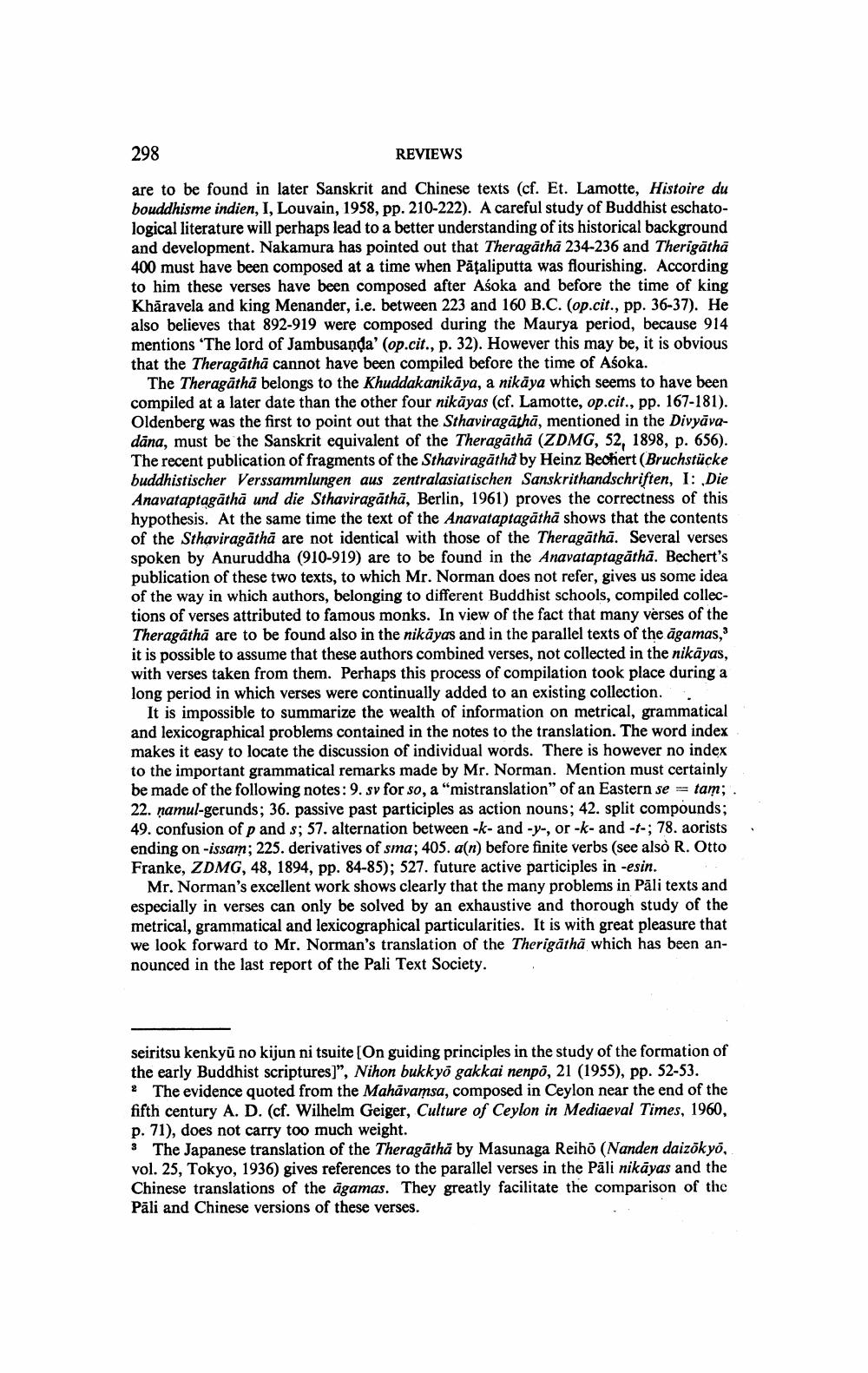Book Title: Reviews Of Different Books Author(s): Publisher: View full book textPage 2
________________ 298 REVIEWS are to be found in later Sanskrit and Chinese texts (cf. Et. Lamotte, Histoire du bouddhisme indien, I, Louvain, 1958, pp. 210-222). A careful study of Buddhist eschatological literature will perhaps lead to a better understanding of its historical background and development. Nakamura has pointed out that Theragatha 234-236 and Therigatha 400 must have been composed at a time when Pasaliputta was flourishing. According to him these verses have been composed after Asoka and before the time of king Kharavela and king Menander, i.e. between 223 and 160 B.C. (op.cit., pp. 36-37). He also believes that 892-919 were composed during the Maurya period, because 914 mentions 'The lord of Jambusanda' (op.cit., p. 32). However this may be, it is obvious that the Theragatha cannot have been compiled before the time of Asoka. The Theragatha belongs to the Khuddakanikaya, a nikaya which seems to have been compiled at a later date than the other four nikayas (cf. Lamotte, op.cit., pp. 167-181). Oldenberg was the first to point out that the Sthaviragatha, mentioned in the Divyavadana, must be the Sanskrit equivalent of the Theragatha (ZDMG, 52, 1898, p. 656). The recent publication of fragments of the Sthaviragatha by Heinz Bechert (Bruchstucke buddhistischer Verssammlungen aus zentralasiatischen Sanskrithandschriften, I: Die Anavataptagatha und die Sthaviragatha, Berlin, 1961) proves the correctness of this hypothesis. At the same time the text of the Anavataptagatha shows that the contents of the Sthaviragatha are not identical with those of the Theragatha. Several verses spoken by Anuruddha (910-919) are to be found in the Anavataptagatha. Bechert's publication of these two texts, to which Mr. Norman does not refer, gives us some idea of the way in which authors, belonging to different Buddhist schools, compiled collections of verses attributed to famous monks. In view of the fact that many verses of the Theragatha are to be found also in the nikayas and in the parallel texts of the agamas, it is possible to assume that these authors combined verses, not collected in the nikayas, with verses taken from them. Perhaps this process of compilation took place during a long period in which verses were continually added to an existing collection. .. It is impossible to summarize the wealth of information on metrical, grammatical and lexicographical problems contained in the notes to the translation. The word index makes it easy to locate the discussion of individual words. There is however no index to the important grammatical remarks made by Mr. Norman. Mention must certainly be made of the following notes: 9. sv for so, a "mistranslation" of an Eastern se = tam; . 22. namul-gerunds; 36. passive past participles as action nouns; 42. split compounds; 49. confusion of p and s; 57. alternation between -k-and-y-, or-k- and -t-; 78. aorists ending on -issam; 225. derivatives of sma; 405. a(n) before finite verbs (see also R. Otto Franke, ZDMG, 48, 1894, pp. 84-85); 527. future active participles in -esin. Mr. Norman's excellent work shows clearly that the many problems in Pali texts and especially in verses can only be solved by an exhaustive and thorough study of the metrical, grammatical and lexicographical particularities. It is with great pleasure that we look forward to Mr. Norman's translation of the Therigatha which has been announced in the last report of the Pali Text Society. seiritsu kenkyu no kijun ni tsuite [On guiding principles in the study of the formation of the early Buddhist scriptures]", Nihon bukkyo gakkai nenpo, 21 (1955), pp. 52-53. 2 The evidence quoted from the Mahavamsa, composed in Ceylon near the end of the fifth century A. D. (cf. Wilhelm Geiger, Culture of Ceylon in Mediaeval Times, 1960, p. 71), does not carry too much weight. 3 The Japanese translation of the Theragatha by Masunaga Reiho (Nanden daizokyo, vol. 25, Tokyo, 1936) gives references to the parallel verses in the Pali nikayas and the Chinese translations of the agamas. They greatly facilitate the comparison of the Pali and Chinese versions of these verses.Page Navigation
1 2 3 4 5 6 7 8 9 10 11 12 13 14 15 16 17 18 19 20 21 22 23
